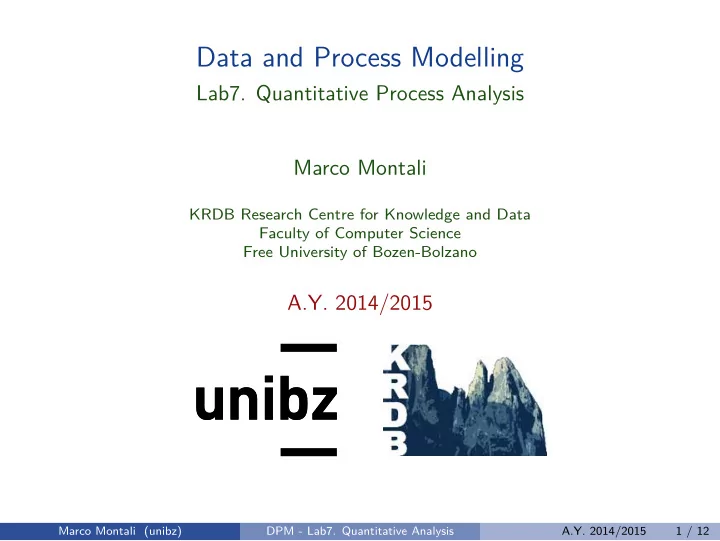

Data and Process Modelling Lab7. Quantitative Process Analysis Marco Montali KRDB Research Centre for Knowledge and Data Faculty of Computer Science Free University of Bozen-Bolzano A.Y. 2014/2015 Marco Montali (unibz) DPM - Lab7. Quantitative Analysis A.Y. 2014/2015 1 / 12
Process Analysis A set of techniques to assess the quality, the correctness, and the suitability of a process model at design time. • Qualitative analysis deals with understanding the quality of a business process model, with eliciting potential issues and their causes, and ultimately improve the model itself. ◮ Value-added analysis. ◮ Cause-effect and why-why analysis. ◮ Issue register. • Quantitative analysis aims at providing quantitative insights about the process performance and involved effort, typically measured in terms of time and costs. ◮ Flow analysis. ◮ Queuing analysis and simulation. • Formal analysis checks whether the dynamics induced by a process model guarantee key (correctness) properties. ◮ Generic correctness properties (deadlock, termination, soundness). ◮ Domain-dependent properties, typically via temporal model checking. Marco Montali (unibz) DPM - Lab7. Quantitative Analysis A.Y. 2014/2015 2 / 12
Process Performance Dimensions Time Performance related to how much does the process execution impact on the amount of work in the company, especially by considering the average time taken to execute a single case (cycle time). Cost Performance related to how much does the process execution impact in financial terms on average. Quality Performance related to how much does the process satisfy its customers (external quality), and how much is the process in line with the expectations of the organization (internal quality). These abstract dimensions are typically refined into key performance indicators (KPIs) that can be unambiguously determined and measured. Marco Montali (unibz) DPM - Lab7. Quantitative Analysis A.Y. 2014/2015 3 / 12
Flow Analysis A family of techniques for estimating the overall performance of a process given some knowledge about the performance of its tasks. We apply flow analysis to: • Calculate the overall cycle time ( CT ) of a process, by starting from the expected execution times for its tasks. • Calculate the overall cost ( C ) of a process, by starting from the expected costs for its tasks. Main simplifying assumption: the process is block-structured. • It can be seen as the recursive composition of single input single output (SESE) blocks, each of one of the following kinds: ◮ Entire process. ◮ Single task. ◮ Choice block (X). ◮ Parallel block (+). ◮ Loop block (also called rework). Second simplifying assumption: no resource contention. Marco Montali (unibz) DPM - Lab7. Quantitative Analysis A.Y. 2014/2015 4 / 12
Cycle Time Calculation: Entire Process CT CT =? Marco Montali (unibz) DPM - Lab7. Quantitative Analysis A.Y. 2014/2015 5 / 12
Cycle Time Calculation: Single Task Base case of the recursive calculation. T CT = T (given) Marco Montali (unibz) DPM - Lab7. Quantitative Analysis A.Y. 2014/2015 6 / 12
Cycle Time Calculation: Sequence Cumulative effect. T 1 T 2 CT = T 1 + T 2 Marco Montali (unibz) DPM - Lab7. Quantitative Analysis A.Y. 2014/2015 7 / 12
Cycle Time Calculation: Choice Weighted average based on given choice probabilities, assuming that n � p i = 1 i =1 T 1 p 1 p 2 T 2 X X ... p n T n n � p i × T i CT = i =1 Marco Montali (unibz) DPM - Lab7. Quantitative Analysis A.Y. 2014/2015 8 / 12
Cycle Time Calculation: Parallel Critical path estimation. T 1 T 2 + + ... T n � � T i | i ∈ { 1 , . . . , n } CT = max Marco Montali (unibz) DPM - Lab7. Quantitative Analysis A.Y. 2014/2015 9 / 12
Cycle Time Calculation: Rework Undefined number of iterations - rework probability. 1-r X T X r T + r × T + r 2 × T + r 3 × T + . . . CT = ∞ T r i = � T × = 1 − r i =0 Marco Montali (unibz) DPM - Lab7. Quantitative Analysis A.Y. 2014/2015 10 / 12
Flow Analysis for Cost Calculation Same as cycle time, except for parallel SESE blocks, which give raise to a cumulative cost. C 1 C 2 + + ... C n n � C = C i i =0 Marco Montali (unibz) DPM - Lab7. Quantitative Analysis A.Y. 2014/2015 11 / 12
Cycle Time and Work-In-Process Cycle time ( CT ) relates to two other key time measures: • Arrival rate λ : average number of new cases that are created per time unit. • Work-in-process WIP : average number of cases that are simultaneously active. Little law For stable processes : WIP = λ × CT Stable process: process whose active instances do not increase infinitely. Some insights: • If the process slows down (i.e., CT increases), then the number of simultaneously active instances increases • If the arrival rate increases and we want to keep WIP constant, we have to reduce CT . • Supports an alternative calculation of CT w.r.t. flow analysis. Marco Montali (unibz) DPM - Lab7. Quantitative Analysis A.Y. 2014/2015 12 / 12
Recommend
More recommend